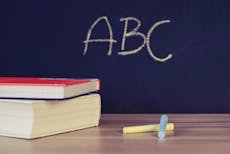Study Guide for Renaissance Star Testing: with Tips
All products and services featured are independently selected by WikiJob. When you register or purchase through links on this page, we may earn a commission.
- A List of Renaissance STAR Tests Available for Practice in 2025
- What Is Renaissance Star Testing?
- The Renaissance Star Assessment Scoring System
- Types of Renaissance Star Assessments
empty
empty
empty
empty
empty
- Renaissance Star Testing Sample Questions
empty
empty
empty
- How to Prepare for the Renaissance Star Assessment
- Frequently Asked Questions
- Final Thoughts
The Renaissance Star tests are not pass-or-fail assessments, but give insight into your child’s current Math and English abilities to help support their educational development.
Results are in the form of scale scores – with different school grades expected to fall within different score ranges.
Renaissance Star testing is commonly used in the US to review the progress and development of students from pre-K to 12th grade.
These computer adaptive tests are administered throughout the school year to assist schools in providing the right level of educational support for each child.
This article will cover the purpose of Renaissance Star testing, the different types of Renaissance Star test and the test scoring system. It will also provide sample questions and tips to help give your child the best chance to excel.
A List of Renaissance STAR Tests Available for Practice in 2025
- STAR Math 3th & 4th Grade
- STAR Math 5th & 6th Grade
- STAR Reading 3th & 4th Grade
- STAR Reading 5th & 6th Grade
- STAR Early Literacy
What Is Renaissance Star Testing?
Renaissance Star tests are given by schools to track the development of pupils across grades.
The tests are set at different levels to be appropriate for different ages and cover three areas:
- Math
- Reading
- Early Literacy
The tests are computer adaptive (or CAT), which means the questions posed become easier or harder depending upon a child’s performance. This provides a unique and tailored test to each child and their ability level.
It ensures the test isn’t too challenging and therefore overwhelming, which can damage a child’s learning confidence.
The results of the Renaissance Learning Star tests are used to obtain an accurate picture of a child’s abilities. Knowing these areas of strength and weakness can ensure that they receive the right level of support at school and at home.
They may be used to determine which classes a child is assigned to or whether they are selected for more advanced or accelerator math and reading programmes.
The tests are often given multiple times throughout the year, so that schools can keep a close eye on evolving learning and development needs.
Schools use Renaissance Star testing according to their own requirements, so the administration and use of the tests can vary according to school district, school or even teacher.
Take a Practice Renaissance Star Test on TestPrep-Online
Renaissance Star tests have no set time limit, but should take between 15 and 30 minutes to complete, depending upon the topic.
Before exploring the different tests, you’ll learn more about the scoring system, so the score ranges of the tests make sense.
The Renaissance Star Assessment Scoring System
The Renaissance Star assessments are not pass or fail tests, but a guide to help understand your child’s educational development and meet learning outcomes.
Results are in the form of scale scores – this means that the raw score is converted so it sits on a standardized scale. The number of questions and the difficulty of the questions (different for each child due to the adaptive nature of the test) factor into the final score.
Renaissance Star Reading scores range from 0 to 1,400 – and this is the same for the Renaissance Star Math test. Where a score falls in this range will determine its grade level.
For example, a reading scaled score of 0 to 400 corresponds to grades 1 to 4, whilst a score of between 400 and 800 corresponds to grades 4 to 8. The average score range for each test differs depending upon the grade.
Unfortunately, the results of the tests are not available for parents to view. The child's school will review them and subsequently involve parents in any discussions needed around their child's progress or potential.
Types of Renaissance Star Assessments
The Renaissance Star assessment types are:
Star Reading
The Star Reading test covers grades K through 12, testing appropriate reading skills with questions of different levels of difficulty according to grade. It features 34 questions and has a guide completion time of 20 to 30 minutes.
Renaissance Star Reading scores range from 0 to 1,400.
The questions cover the following skill areas:
- Vocabulary – Word Knowledge and Skills
- Comprehension – Comprehension Strategies and Constructing Meaning
- Literacy – Analyzing Literary Text
- Author – Understanding the Author’s Craft
- Argument – Analyzing Argument and Evaluating Text
Star Math
The Star Renaissance Math test has the same parameters as the Reading test, covering grades K to 12.
It also presents 34 questions to be completed in around 20 to 30 minutes and has a score range of 0 to 1,400.
The questions cover:
- Algebra
- Numbers and operations
- Geometry and measurement
- Data analysis, statistics and probability
Star Early Literacy
The Star Early Literacy test is for pre-K to 3 and it should take around 20 minutes to answer its 27 questions. The average score range of the test is 300 to 900.
The questions cover:
- Alphabetic Principles (grades pre-K to kindergarten)
- Concept of Word (pre-K to kindergarten)
- Visual Discrimination (pre-K to kindergarten)
- Phonemic Awareness (pre-K to 1st grade)
- Phonics (kindergarten to 3rd grade)
- Structural Analysis (1st to 3rd grade)
- Vocabulary (kindergarten to 3rd grade)
- Sentence-Level Comprehension (1st to 3rd grade)
- Paragraph-Level Comprehension (1st to 3rd grade)
Star CBM
The Star CBM assessment uses curriculum based-measures to evaluate the math and reading ability of elementary school students. It is designed to be administered in a one-on-one setting.
Other Assessments
The Star Spanish test is not a Spanish language test, but the assessment for reading, math and literacy in Spanish to support bilingual students.
The Star CBM Lectura looks at K through 6 students’ literacy development in Spanish.
There is also a Star Custom test option, which allows education providers to build a custom assessment for a specific candidate or group.
Renaissance Star Testing Sample Questions
Below are some examples of the style of question to expect on the reading and mathematics tests.
Whilst the Star Renaissance tests are not assessments that need to be specifically studied for – as they are intended to obtain a picture of current ability level – it is useful for your child to be familiar with the format of the test and type of questions featured, so they know what to expect on the day of testing.
Renaissance Star Reading Test: Sample Questions
Grade 1 to 2 Example Question
1. Read the following story:
On Wednesdays Ben visits his Nan. He likes to help her in the kitchen. He also often makes them a cup of tea and they sit on the sofa.
Which trait describes Ben?
a) Lazy
b) Kind
c) Excitable
d) Curious
Take More Grade 1 to 2 Example Questions at TestPrep-Online
1. Lily is giving a presentation to her class about the decline of the wild tiger population.
What should she use to best explain her point?
a) A photograph of an endangered tiger
b) A graph showing the decrease in population numbers
c) A map showing where the largest remaining tiger populations live
Take More Grade 3 to 4 Example Questions at TestPrep-Online
1. Katie said she has nearly 20 different dresses in her closet. Katie is probably trying to explain that she _____:
a) should clean her closet
b) is trying to break a world record
c) has a lot of dresses to wear
Take More Grade 5 to 6 Example Questions at TestPrep-Online
1. Sarah saw 18 dogs in the park and 7 dogs on the walk home. How many dogs did she see in total?
a) 22
b) 30
c) 35
d) 25
2. What is this shape called?

a) Square
b) Circle
c) Triangle
d) Hexagon
1. Which answer shows a couple list of factor pairs for the number 36?
a) 1, 36 | 2, 18 | 3, 12 | 4, 9 | 6, 6
b) 2, 18 | 4, 12 | 5, 6
c) 1, 36 | 3, 12 | 4, 9 | 6, 6
d) 1, 36 | 2, 18 | 3, 12 | 4, 8
1. If the radius of a circle is 7 inches, then what is the diameter?
a) 12 inches
b) 14 inches
c) 16 inches
d) 18 inches
Which word rhymes with 'cat'?
a) Dog
b) Hat
c) Book
d) Chair
What is the beginning sound of the word 'ball'?
a) b
b) m
c) p
d) s

If you want 12-month access to all the practice resources for this test, our partner TestPrep-Online.com offers a Family Membership.
Family Membership gives you access to all the TestPrep-Online resources for the next 12 months. You will also get two separate accounts, which can be very helpful if you have two children preparing for their tests.
Get a Family Membership with 12-month access
How to Prepare for the Renaissance Star Assessment
The Renaissance Star tests are indicators of a child's current ability level and progress, so they aren't tests to be studied for in the traditional sense – teachers require an accurate insight into ability level, not one influenced by disproportionate amounts of preparation.
There are, however, actions you can take throughout the school year to help your child prepare for the assessments.
Some top tips for ensuring your child is confident in approaching the Renaissance Star tests are outlined below:
Step 1. Understand CAT-Style Tests
Renaissance Star tests are computer adaptive, so the difficulty level of the questions will shift depending upon the number of correct or incorrect answers being given.
Explain this to your child so they are aware that the difficulty of the test may fluctuate throughout.
Knowing the test is computer adaptive may also help to alleviate any anxiety around challenging questions as, if the level is too tricky, the test will adjust.
Step 2. Take Renaissance Star Practice Tests Online
Although practicing for the Renaissance Star tests is not necessary, it is a good idea to familiarize your child with the format, style, and content of the test before they encounter it at school.
Having been through an example paper, your child will know what to expect and the test will seem less daunting, helping them to perform at their best on the real test.
TestPrep–Online offers Renaissance Star Reading practice tests, Renaissance Star Math practice tests, sample papers and further practice opportunities.
Step 3. Discover Your Child’s Strengths and Weaknesses
Being aware of your child’s strengths and weaknesses will enable you to help them keep up with their learning and help them achieve a higher score on the test.
It is also important that, if your child struggles with particular skills that are necessary for sitting a test of this kind – such as concentration – that you can help develop these ahead of the test.
Step 4. Talk About the Test to Your Child
Talking about the test will help to dissuade any worries – the Renaissance Star is not a test to be concerned about, but an evaluation of where your child is at.
It also won’t cover the material learned in class, but present questions that assess general ability, which may be confusing if not expected.
Explain that you cannot pass or fail the test in the traditional sense and that there are no negative repercussions from performance level.
The test is a touch point to help ensure the school is providing support in the right ways and is there to be constructive, not detrimental.
Step 5. Practice Time Management and Concentration
Taking tests such as the Renaissance Star assessments requires a lot of concentration, particularly for younger children. Practice focusing on a single task with your child, so they get used to seeing an activity through to completion.
The Renaissance Star tests aren't timed, but they should be completed within the recommended time window. If a child takes longer to complete the test, this will impact the perception of their current ability.
To avoid an incorrect impression, ensure your child knows to work through the questions one at a time and to move on to the next one once they have given their answer.
Step 6. Learn Through Play
The best way to supplement your child’s education, particularly at a young age, is by learning through play.
Complete fun activities with your child, such as number and word games to increase understanding of math and literacy in an enjoyable context.
To improve reading, literacy and many other skills, read a lot with your child or encourage them to read independently (if they are at an age where this is possible and it’s something they enjoy).
Reading is one of the best ways to improve educational attainment.
Renaissance Star tests are online assessments for children pre-K to12 covering Math, Reading and Early Literacy. The tests are made up of mostly multiple-choice questions.
Renaissance Star tests are used by schools to gain insight into a child’s current abilities across English and Math. They are administered at various points throughout the school year to track progress.
You cannot pass or fail Renaissance Star testing in the traditional sense, as it’s designed to evaluate students’ ability on a sliding scale. The test is computer adaptive so, although there may be some trickier questions, the difficulty level shouldn’t too far exceed ability.
Practice papers for the Renaissance Star tests – Reading and Math – are available through TestPrep–Online for Grade 1 to 2, Grade 3 to 4 and Grade 5 to 6.
The test results are important progress markers that schools can use to ensure they are providing the right support and meeting a child’s educational development needs. They are not, however, anything to be nervous about.
The Renaissance Star tests are not timed, but have recommended completion windows of between 15 and 30 minutes, depending on the test.
No, you cannot fail the Renaissance Star tests. A lower score will highlight areas of weakness so the right support can be given to help your child improve their attainment.
The Renaissance Star scores are adjusted to a standardized scale. The brackets on the score range relate to different grade levels, so a good score looks different for children of different ages.
Individual scores are internal for schools and aren’t released to parents.
Renaissance Star Reading practice tests and Renaissance Star Math practice tests for different school grades are available via TestPrep–Online. These can help your child to familiarize themselves with the format and style of the questions on the test.
The Renaissance Star scores of individual students are not released to parents, but used internally by schools. This means that, unfortunately, you will not be able to review your child’s test performance.
As you cannot pass or fail the tests, retaking the Renaissance Star tests is not necessary or possible. They are, however, often administered throughout the school year (depending upon the school’s preference) so there will be an opportunity to complete the tests again.
The more you know about Renaissance Star testing, the better prepared you’ll feel to support your child.
To find out more about the tests, check out the complete guide on TestPrep–Online
Final Thoughts
The Renaissance Star tests are designed to be a tool for education providers to track a child’s progress across Math, Reading and Literacy and ensure they are receiving the support they need at school to meet their learning objectives for each grade.
As such, they are not tests to be concerned about or to prepare heavily for. It is, in fact, important that the tests provide a true representation of your child’s ability.
Ahead of the test, speak to your child about the process and go through some practice questions so the format and style becomes familiar – but avoid putting any pressure upon achieving certain results.
The Renaissance Star tests will be encountered multiple times throughout the school system, so making your child comfortable with taking the assessments will be beneficial to ensure their abilities are accurately gauged.



